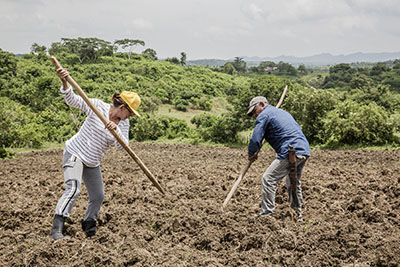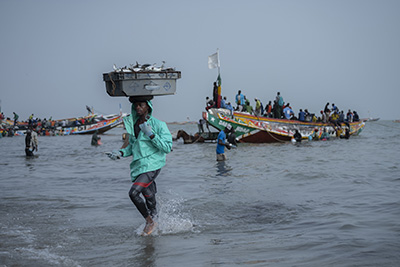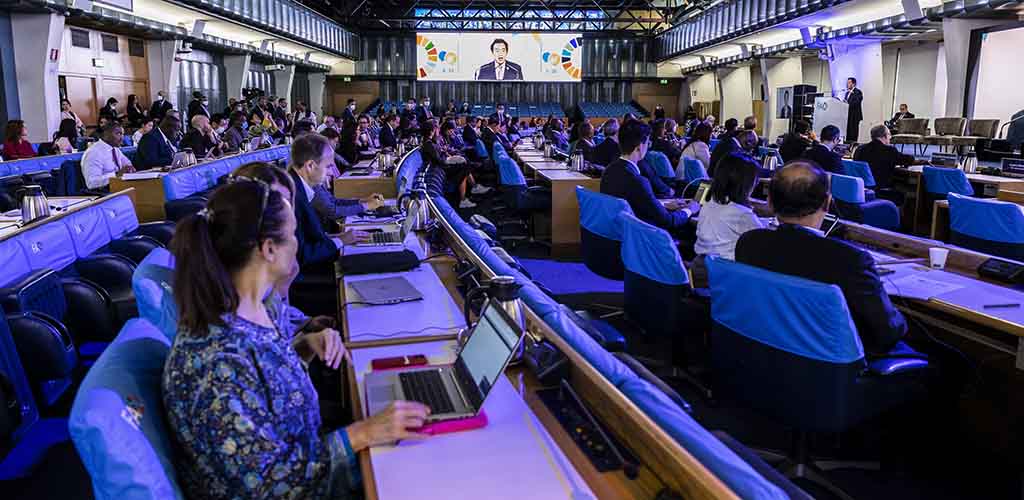FAO in review: Building and deploying professional and practical expertise
Strong flow of technical knowledge products serving all stakeholders has re-positioned FAO globally, in line with its mandate
Workers in a wheat field in Serbia. © FAO/Victor Sokolowicz
The urgency and scale of the challenges they represent are increasingly recognized around the world. That is why FAO has crafted a new Strategic Framework 2022-2031 and why Director-General QU Dongyu has since taking the helm in 2019 insisted on making the Organization more efficient, innovative and effective.
A critical ingredient to make progress on these challenges is to make sure that FAO is globally recognized as a professional, trusted and reliable partner of all shareholders working to eradicate hunger and malnutrition and to support realization of the 2030 Agenda for Sustainable Development and the Sustainable Development Goals.
Great strides have been made in that direction over the past 40 months, testifying to agile and policy-relevant work streams geared towards producing real impacts and actionable information. FAO has re-established itself as a centre of excellence, and its technical specialized knowledge, expertise, information and data are increasingly in demand – from Members, the UN system at large and a widening pool of new partners.
“We are building an FAO that is capable of responding to the fact that agrifood systems are vulnerable to risks and uncertainties,” said FAO Chief Economist Maximo Torero “This ONE FAO brings together all the professional and scientific expertise of FAO responding fast and effectively with data, statistics, tools and relevant policy advice to the challenges we are facing.”


Left: Preparing a yam field in Colombia. © FAO/Patrick Zachmann/Magnum Photo; Right: Carrying fish to shore in Senegal. © FAO/Sylvain Cherkaoui
Responding to multiple crises
When the COVID-19 pandemic broke out, FAO put out more than 70 policy briefs focusing on how to tackle the immense challenges the pandemic so quickly created. Those briefs address topics ranging from protecting the land and rights of Indigenous Peoples in Asia, seasonal migration in Europe, recommended crop calendars in Africa and risks specific to fisheries and aquaculture, to recommendations on how to shore up urban food systems, bolster food safety and ensure and enhance smallholder food producers’ access to markets. The full suite of policy briefs is available here.
The Director-General, joining with his peers at the World Trade Organization and the World Health Organization, immediately called for maintaining the smooth flow of trade essential for agrifood goods and services.
When the conflict in Ukraine affected trade flows, triggering a dangerous availability crisis for food, energy and fertilizers, FAO was quick to provide authoritative assessments, publishing numerous information notes and regularly updating them.
That data was essential in measuring the potential gravity of food shortages in vulnerable countries around the world, leading to FAO’s proposal of a Food Import Financing Facility to help mitigate food security and financial strains for 1.82 billion people living in the 62 most exposed countries. FAO’s Director-General promoted the initiative to major fora including the G20, and its main purposes are now enshrined in the International Monetary Fund’s new Food Shock Window, which on 21 November disbursed its first loan through the new mechanism.
FAO is also operating food insecurity assessments in the 50 most vulnerable countries, collecting primary Food Insecurity Experience Scale data at national and subnational levels to provide timely information on where actions and assistance are most needed.
Meanwhile, FAO has developed an innovative Fertilizer Trade Tracker, an online tool allowing countries to gauge import needs and export availabilities, as well as a fertilizer priority allocation tool for Africa to help policy makers make optimal choices to support their agricultural sectors and is promoting soil nutrient maps to improve the use efficiency of fertilizers.
All of these knowledge products, as well as FAO’s close collaboration with the Agricultural Market Information System (AMIS) inter-agency platform, aim to help FAO’s Members to address the impacts of increasing food prices and access problems, and also provides adequate policy recommendation to avoid a food availability and a food affordability crisis with dire global consequences.
These are all technical outputs designed to produce and accelerate results on the ground.

Director-General QU Dongyu addresses the Hand-in-Hand Investment Forum at FAO in October 2022. © FAO/Cristiano Minichiello
Targeting investments in agrifood systems to increase resilience and sustainability
Looking further ahead and beyond the crises that have roiled the world for the past three years, FAO has sharply intensified its knowledge work to focus on identifying where in agriculture are the most cost-effective sectors for public investment that can support economic development in a way that embeds poverty reduction as a pathway.
A major example of this is the Hand-in-Hand Initiative, which uses an array of analytical tools including geospatial mapping to identify opportunities for new investments to have the highest impact. Nearly $1 billion in fresh investment was pledged from an array of stakeholders at the recent Hand-in-Hand Investment Forum held at FAO in October.
A related workstream has worked with and for governments on research that have led to partner-validated plans for Ecuador, Mexico, Nicaragua, Paraguay and Uganda, with more in the pipeline. As an example of this exercise, FAO provided Uganda’s government with a model-based ranking of where public investments worth a manageable 0.25 percent of gross domestic product would have the most impact in terms of agrifood production, agricultural productivity and in particular on well being and poverty, especially in rural areas.
Other innovative work being done by FAO includes improving measurements of resilience, food and nutrition security, the affordability and accessibility of healthy diets, as well as identifying best practices in social protection programmes, all in ways that are achievable and contribute to multiple and inter-related goals, and promote sustainable transformation of agrifood systems that deliver benefits for all. This work is increasingly integrated into the annual flagship reports on The State of Food Security and Nutrition in the World.
The FAOSTAT data portal, a key resource for all stakeholders, has been significantly enhanced with new domains devoted to identifying where greenhouse gas emissions occur, tracking cropland nutrient budgets to optimize fertilizer use, where monetary resources flow along food value chains, and making agricultural census data from around the world more easily available for analysis.
FAO’s technical expertise is increasingly being put to concrete practical use, in line with the guiding principles of the Four Betters – Better Production, Better Nutrition, a Better Environment and a Better Life - and in line with the new holistic approach to agrifood systems with a focus on improving efficiency, inclusivity, resilience and sustainability, and also on enabling people, especially those in rural areas, women and youth, to have better lives.
Related links
